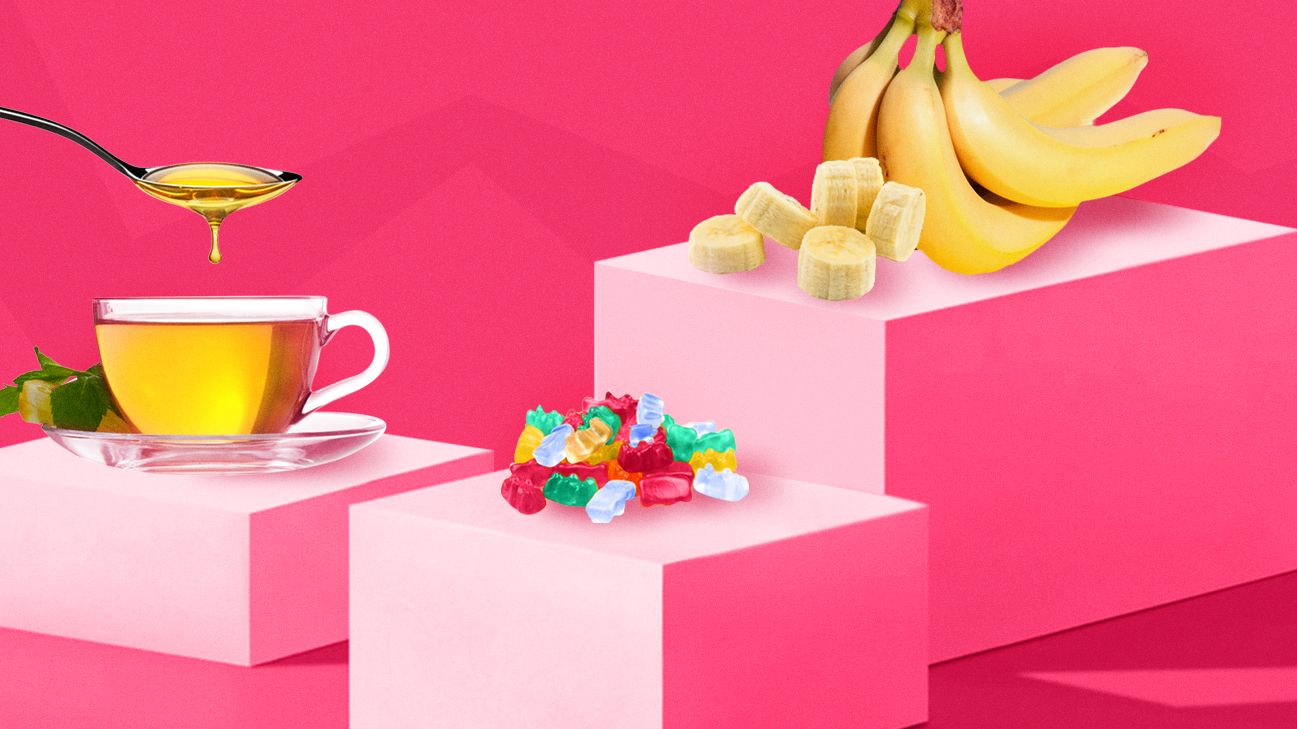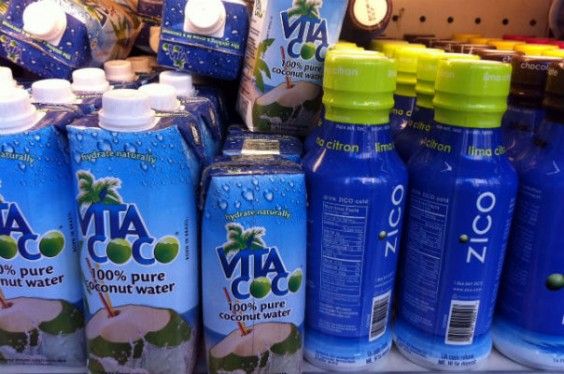We include products we think are useful for our readers. If you buy through links on this page, we may earn a small commission. Here’s our process.
Greatist only shows you brands and products that we stand behind.
Our team thoroughly researches and evaluates the recommendations we make on our site. To establish that the product manufacturers addressed safety and efficacy standards, we:- Evaluate ingredients and composition: Do they have the potential to cause harm?
- Fact-check all health claims: Do they align with the current body of scientific evidence?
- Assess the brand: Does it operate with integrity and adhere to industry best practices?
The feeling of a long run is primal and transcendent. But along with the wind in your hair comes the rumble in your belly — that all-consuming, knee-trembling feeling of nausea that makes you desperate for food while also calling into question your ability to keep it down.
This, right here, is the challenge of the mid-workout snack: It needs to be full of energy and easy to digest. In fact, in the middle of a long run, many conventional dietary rules go out the window.
Rather than protein and healthy fats, your body needs fast-absorbing carbohydrates.
“It’s even a good idea to avoid more fibrous food, like sweet potatoes,” says Jason Fitzgerald from StrengthRunning.com. “The fiber can make stomach cramps worse.”
Mid-run snacking isn’t really necessary unless you’re exercising for longer than an hour.
Here’s what you need to know.
OK, so you wouldn’t call these snacks, per se. But fluids can be a great way to quickly inject nutrients and energy into your bloodstream.
1. Coconut water
Sodium is one electrolyte your body sweats out, but there are many others, including calcium, potassium, and magnesium.
Coconut water gets the nod because it provides all four of the above, as well as phosphorus.
One cup of coconut water also packs about 10 grams of carbs, which is a hearty helping of energy when you need it the most.
We sometimes put chia seeds in our coconut water too.
2. Water and salt
For a more “no-frills” approach, try simply adding 1/8 to 1/4 teaspoon of salt to your water bottle.
We took a dive into whether salt water gargling will prevent COVID-19. Spoiler: It definitely won’t.
3. Flavored water
Want to level up your water? For some extra nutrients and carbs, take the water bottle and cram in some fruit slices, berries, and herbs.
When it comes drinking straight juice, though, be careful. It’s a little too high in fructose, a carbohydrate our bodies don’t process as well as other sugars.
That may impair performance or interfere with fluid absorption.
Some studies suggest that adding adding fructose to a glucose solution actually improves how your body slurps up sodium and water.
Here’s how to nail making your own flavored water.
4. Sports drinks
A 20-ounce bottle of Gatorade has 39.9 grams of carbs. The same amount of Powerade has 48.6 grams of carbs.
A 2008 study suggests that these drinks may help you stay hydrated during exercise,
We found some drinks to give you energy when you’re not pounding the sidewalk.
5. Iced green tea with honey
Straight out of a bee’s face and into your exercise regimen, honey may help fuel the fire. Honey contains more antioxidants than regular sugar.
According to a 2010 study, sipping on green tea during a run can also improve endurance and increase VO2 max (your body’s ability to transport and use oxygen during exercise).
However, that study didn’t use actual green tea — it used capsules of a component of green tea called EGCG. You’d have to drink an awful lot of green tea to get the amount of EGCG in one of those capsules, which isn’t that practical on a long run.
Teas aren’t just good for an energy boost — they can help you snooze too. Here are some teas to help you sleep.
6. Sports gels
Occupying a goopy place somewhere between liquid and food, runners’ gels are manufactured supplements that come in a tremendous variety of flavors and functions.
They tend to tick all the boxes: They’re high in carbohydrates and electrolytes, they digest quickly, and they contain a combo of fructose and maltodextrin, two sugars that, when working in tandem, may enhance athletic performance.
They’re reasonably portable and tasty, so there’s no real reason to avoid gels unless cost is an issue or you prefer the feeling of eating actual food.
Snacks to munch that pack a punch.
7. Bananas
One medium banana contains 27 grams of fast-digesting carbohydrates that can be just as effective as a carbohydrate drink in terms of performance, blood sugar, and oxidative stress.
Bananas as an energy source during exercise: A metabolomics approach. DOI: 10.1371/journal.pone.0037479
Don’t throw out your old bananas, either — the riper the fruit, the simpler its sugars, and the faster they will be absorbed into your bloodstream. For those looking to keep their blood sugar down, this is bad news. In the middle of a long run, however? Spot-on.
While bananas aren’t always super portable (unless they’re excited about it being peanut butter jelly time), you can always mash them and carry them in a zip-top bag or maybe wrap ’em up in a tortilla with a little cinnamon.
Here are 31 other amazing things you can do with bananas (OMG, not that — get your mind out of the gutter!).
8. Baby food
Hear us out, OK? We know babies don’t often head out on marathon runs.
The strengths of baby food are digestibility and portability: It can be easily stored in a pocket-friendly zip-top bag, and its mashed-up consistency means some of the digestive work is already done (think Mama Bird feeding her fledglings).
This makes baby food a good way to quickly take in the sugars from fruit without removing as many of the nutrients as juicing does.
Using a steamer or microwave is the best way to soften fruits and vegetables while preserving their vitamins. Then throw them in a food processor or mash them by hand.
If you follow a soft food diet, we can help you keep it going.
9. Raisins
Dried fruits are a terrific choice in the middle of a run for the same reason they’re an iffy choice the rest of the time: They’re very high in calories and barely feel like you’re eating anything.
A 2011 study from Louisiana State University found that raisins were just as effective during endurance-based cardio workouts as sports jelly beans (more on those below).
Raisins should make a powerful cameo in any self-respecting trail mix. Learn how to put a trail mix together.
10. Dates
Dates are high in natural sugars (with about 5 grams of sugar each) and potassium (656 milligrams each). This makes them a sweet, energizing choice to pop in your mouth mid-marathon.
11. Dried cherries
Dried cherries pack a decent amount of carbs (97 grams per cup), but they’re also high in fiber, which slows digestion. You might not want to eat a whole cup of any slow-digesting food right in the middle of a run.
However, an injection of carbs is an injection of carbs. And if you really like the taste of cherries, eating just a few could be just the perk you need after an hour of hard work.
12. Gummy bears
OK, this is… what?
Hear us out. With lots of sugar and virtually no fat or fiber to slow their absorption, these candies, astoundingly, may not be a terrible idea during a long run.
Nonetheless, we’d prefer food that brings at least some nutrients to the table. These are kind of a last resort.
Here’s some Halloween candy that won’t do quite as much damage as other sweets.
13. Marshmallows
This is the last candy on the list, we promise. Not only are marshmallows just as tasty as gummy bears (or jelly beans, for that matter), they’re also more portable.
Sweaty hands can make it difficult to open a plastic bag, and leaving anything gummy in a pocket next to your sweaty body on a hot day might result in a pocket full of sticky, inedible goo — which helps no one.
If overheating is an issue, marshmallows might have you covered, since they don’t melt as easily as gummies.
14. Homemade energy bars
This is a great way to combine several foods on this list.
Nuts, coconut, and seeds tend to be energy-bar staples. Those are all fatty (but healthy) foods, but the servings are likely to be small enough that it’s not much of an issue.
You can play around with different combinations, but dates, figs, honey, and brown rice syrup are great binders, and sugary combos like Rice Krispies and marshmallow are fair game too.
Just remember to maximize the amount of carbs per serving and include plenty of salt. The rest is between you and your taste buds!
15. Jam/honey sandwich
If the bread is white (for those sweet, sweet carbs) and there’s no fatty peanut butter slowing down digestion, this is a delicious way to shuttle a lot of simple sugars into those aching calves.
However, unless someone is waiting with a snack tray at the halfway mark, portability might be an issue. Maybe bring your butler on the run with you?
It may be better to make mini tortilla roll-ups instead. You can carry those a little more easily.
We found 15 other sandwiches that won’t get soggy when you’re out and about.
16. Pretzels
Some people tout pretzels, which are high in refined carbs and pack plenty of sodium, as a good choice for replenishing your energy and salt stores — particularly since they’re low in fiber and won’t take long to hit your bloodstream.
As with candy, however, it’s better to eat more natural foods that will supply some vitamins. (But you can still buy some online if they tickle your fancy.)
You can even eat pretzels on a keto diet. We give you the lowdown on keto comfort foods.
17. Frozen grapes
They’re easy to carry, high in sugar, relatively low in fiber, and refreshing as hell.
Plus, a burst of cold, juicy revitalization may be just what you need 10 miles into your personal best.
If marathon running were easy, everyone would do it. But it doesn’t have to be needlessly hard, and you now have loads of ways to make it easier on yourself and your muscles.
A mid-run nutrient boost will help you focus less on feeling hungry and more on feeling like the badass you are.
We also put together some tips on how to bring down your lap time.



